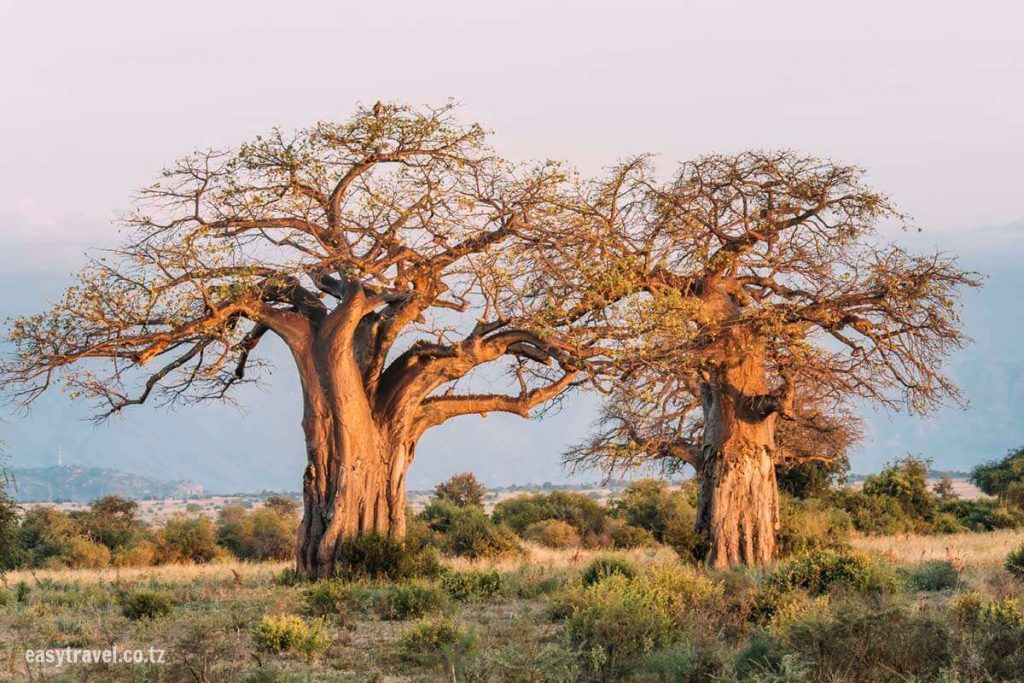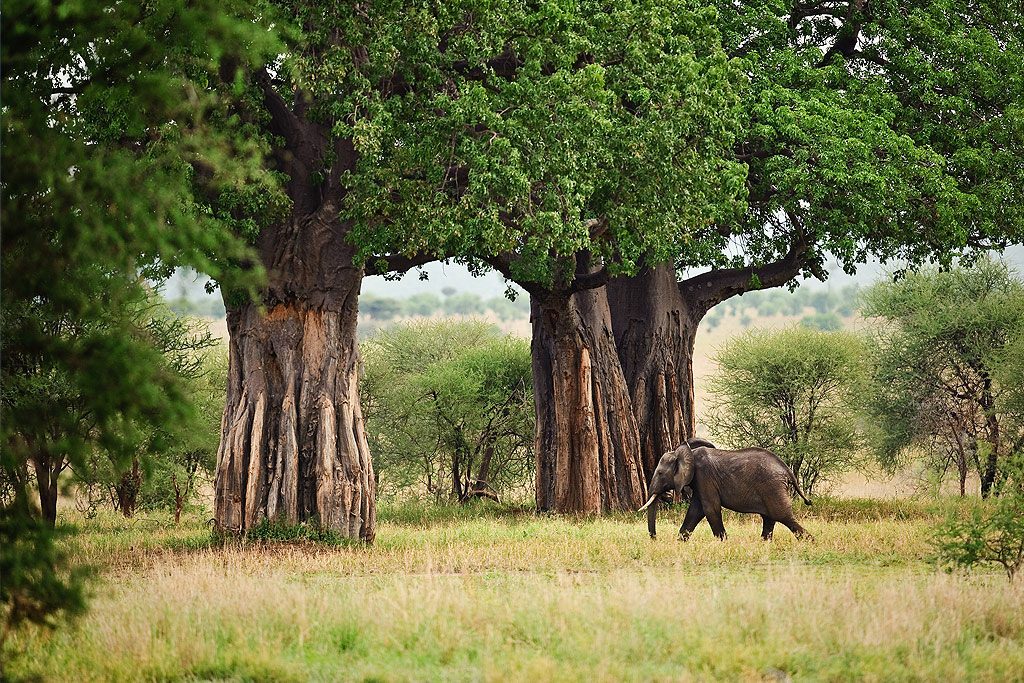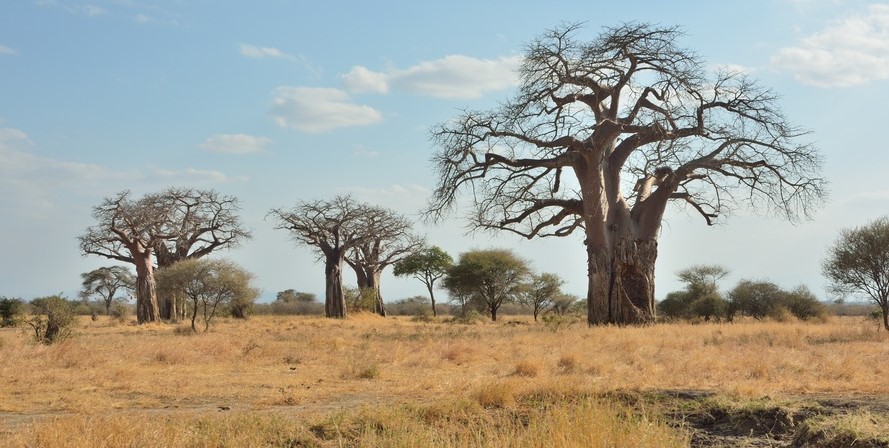The Majestic Baobab Trees of Tarangire




When you think of Tarangire National Park, one of Tanzania’s most iconic wildlife destinations, the first images that often come to mind are the incredible wildlife and vast landscapes. However, there’s one feature of the park that stands out as a symbol of its beauty and uniqueness: the Tarangire Baobab Trees. These ancient and majestic trees dot the landscape, creating an unforgettable scenery that is as much a part of the park’s identity as its famous wildlife. In this article, we will explore the significance of the Tarangire Baobab Trees, their cultural importance, and how they enhance the safari experience.
1. What Are Baobab Trees?
Baobab trees, also known as Adansonia, are large, deciduous trees native to Africa. These iconic trees are instantly recognizable by their large, swollen trunks and spindly branches that resemble upside-down roots. Their wide trunks, which can grow up to 10 meters in diameter, are designed to store large amounts of water, making them resilient during the dry season. The baobab’s unusual appearance, along with its ability to live for over a thousand years, gives it a legendary status among the local communities and wildlife enthusiasts.
In Tarangire National Park, these trees are a prominent feature of the landscape, particularly scattered throughout the park’s plains and the fringes of the Tarangire River. Their vast presence in this area creates a surreal atmosphere, where the towering trees stand like ancient sentinels watching over the savannah below.
2. The Baobab Trees of Tarangire: A Landscape Like No Other
The Tarangire Baobab Trees have become synonymous with the park’s unique charm. While baobabs are found in other parts of Africa, the density and grandeur of these trees in Tarangire are unparalleled. As you journey through the park, you’ll notice these towering trees rising above the plains, their thick trunks and wide canopies offering shade to both animals and humans alike.
The best time to witness the grandeur of the Tarangire Baobab Trees is during the dry season, between June and October. As the rest of the landscape dries out, the baobabs retain their beauty, standing tall against the backdrop of golden grasses and parched earth. Their striking silhouettes against the clear blue skies are perfect for photography, making them a favorite subject for safari photographers.
In addition to their beauty, the baobabs provide crucial resources for the wildlife of Tarangire. The dense foliage offers shelter for various species of birds, including hornbills, and the water-storing trunks serve as a vital source of hydration for elephants and other large mammals during the dry months.
3. Ecological Role of the Baobabs
The Tarangire Baobab Trees play a vital ecological role within the park. Beyond their majestic appearance, these trees provide shelter, food, and water to numerous species. The large hollow trunks of the baobabs often become homes for various animals, such as bees, squirrels, and birds. Their flowers, which bloom in the wet season, attract a variety of pollinators, including bats and butterflies.
Baobabs are also integral to the diet of several animals, particularly elephants. During the dry season, elephants often break off chunks of the baobab’s bark, leaves, and even the wood itself to consume. The water stored inside the tree’s trunk can also be accessed by thirsty wildlife when other water sources are scarce.
In addition, baobabs serve as a habitat for certain species of insects, including termites, which help in decomposing the trees when they begin to die. This natural process ensures the cycle of life continues within the ecosystem, enriching the soil and supporting new growth.
4. The Cultural Significance of Baobabs
The Tarangire Baobab Trees are not just significant from an ecological perspective—they also hold a deep cultural and spiritual significance. In many African cultures, baobabs are considered sacred trees. They are often thought to be a bridge between the physical and spiritual worlds. Local communities view the baobab as a symbol of resilience and longevity due to its ability to thrive in harsh environments and live for centuries.
In Tarangire, the baobabs are integral to the local Maasai people’s way of life. The trees are used for medicinal purposes, and their fruits, known as “monkey bread,” are consumed by the Maasai for their high vitamin C content. Some also believe the baobab tree has healing powers and turn to it for spiritual guidance and protection.
5. Why Tarangire’s Baobab Trees Are a Photographer’s Dream
The Tarangire Baobab Trees are not only iconic because of their size and age—they also offer fantastic opportunities for wildlife and landscape photography. The unique shape of the baobab trees, combined with the park’s stunning vistas, creates the perfect conditions for breathtaking photos. The golden hues of the dry season, with the deep blue sky as a backdrop, make for striking compositions, especially at sunrise or sunset when the soft light highlights the trees’ intricate details.
Photographers can also capture the contrast between the massive baobab trunks and the smaller creatures that interact with them. Elephants are often seen munching on the baobabs, making for an impressive wildlife shot with the tree as the focal point. Additionally, the large expanse of Tarangire, with its open savannah dotted with baobabs, provides ample opportunities to capture the natural beauty of the park.
6. A Symbol of Conservation
The Tarangire Baobab Trees also play an important role in conservation efforts. Their presence in the park contributes to the biodiversity of the region, supporting a wide array of species. Efforts to protect and conserve Tarangire’s wildlife naturally include safeguarding the iconic baobabs, as they form an integral part of the park’s ecosystem.
In recent years, there has been growing awareness of the importance of these trees. Climate change, illegal logging, and land degradation have put baobabs and other native trees at risk. Thankfully, conservation programs in Tarangire National Park continue to prioritize the preservation of the baobabs, ensuring they remain a symbol of the park’s remarkable natural heritage.
7. How to Experience the Baobabs in Tarangire
To fully experience the beauty and significance of the Tarangire Baobab Trees, it’s recommended to embark on a guided safari through the park. Professional guides can offer fascinating insights into the biology and history of the baobabs, as well as point out specific trees that have become landmarks due to their age or unusual features. For photographers, early morning and late afternoon game drives are the best times to capture the iconic baobabs against the soft, golden light of the day.
For those seeking a deeper connection to the trees, some of the lodges and camps in Tarangire offer guided walks through the park, where guests can learn more about the baobabs and the animals that rely on them. These walks give visitors a chance to appreciate the park’s flora and fauna at a slower pace, offering intimate views of the majestic trees up close.
8. Conclusion: The Iconic Baobabs of Tarangire
The Tarangire Baobab Trees are more than just a scenic feature of the park; they are an integral part of its ecosystem, a symbol of its resilience, and an enduring connection to Africa’s natural and cultural heritage. Whether you are visiting Tarangire for its wildlife, its landscapes, or its unique cultural aspects, the sight of these towering giants will undoubtedly leave a lasting impression. A safari through Tarangire is not complete without a moment to stop and admire these majestic trees, which stand as timeless sentinels over the African wilderness.

One Comment